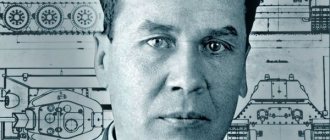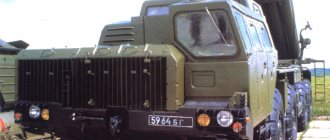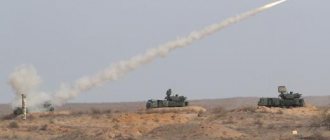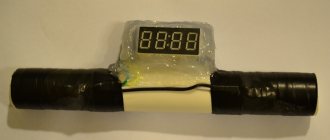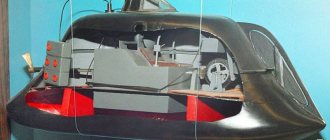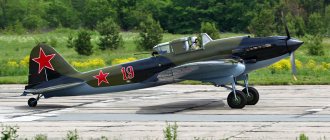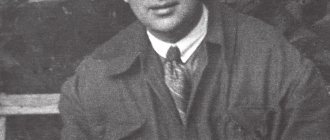This man had an amazing destiny. In his youth, he did not even think about what would later become the main work of his life. Koshkin did not live long, managing to build only one tank, to which he devoted all his strength and life itself. His grave was not preserved, and his name never thundered throughout the world.
But the whole world knows his tank. The T-34 is the best tank of the Second World War, a tank whose name is inseparable from the word “Victory”.
Soviet medium tank T-34 (manufactured in 1941). Photo: Commons.wikimedia.org
"Sweet life
Mikhail Ilyich Koshkin was born on December 3, 1898 into a peasant family in the village of Brynchagi, Uglich district, Yaroslavl province. The family had little land, and Mikhail’s father, Ilya Koshkin, was engaged in fishing. Misha was not even seven when his father died in 1905 after overstraining himself while logging. The mother was left with three young children in her arms, and Mikhail had to help her earn a piece of bread.
At the age of fourteen, Misha Koshkin went to work in Moscow, becoming an apprentice in the caramel shop of the confectionery factory, now known as Red October.
The “dolce life” ended with the outbreak of the First World War, which continued into civil war. The former private of the 58th Infantry Regiment joined the Reds, fought in the ranks of the Red Army near Tsaritsyn, near Arkhangelsk, and fought against Wrangel’s army.
A brave, proactive and determined fighter was made a political worker. After several wounds and suffering from typhus, he was sent to Moscow, to the Sverdlov Communist University. A promising leader was considered in Koshkin.
In 1924, a university graduate, Koshkin, was entrusted with the management of... a confectionery factory in Vyatka. There he worked until 1929 in various positions and got married.
It would seem, how could tanks appear in the fate of this man?
Mikhail Koshkin (right) in Crimea. Early 1930s. Photo: Commons.wikimedia.org
The Motherland needs tanks!
It should be noted that until 1929 in the Soviet Union, the tank industry was a very pitiful sight. Or rather, it simply did not exist. Captured vehicles inherited from the White Army, insignificant in-house production, lagging behind the best world models for an eternity...
In 1929, the government of the country decided that the situation must be changed radically. It is impossible to ensure the country's security without modern tanks.
Personnel, as you know, decide everything. And if there are none, they need to be prepared. And party worker Mikhail Koshkin, who by that time was already over 30, was sent to the Leningrad Polytechnic Institute to study at the Department of Automobiles and Tractors.
It is difficult to master a new business practically from scratch, but Koshkin had enough stubbornness and determination for two.
Theory without practice is dead, and while still a student, Koshkin worked in the design bureau of the Leningrad Kirov Plant, studying models of foreign tanks purchased abroad. He and his colleagues are not only looking for ways to improve existing technology, but also hatching ideas for a fundamentally new tank.
After graduating from university, Mikhail Koshkin has been working in Leningrad for more than two years, and his abilities begin to reveal themselves. He quickly makes his way from an ordinary designer to deputy head of the design bureau. Koshkin participated in the creation of the T-29 tank and an experimental model of the T-111 medium tank, for which he was awarded the Order of the Red Star.
Koshkin and others
Mikhail Koshkin (right) in Vyatka.
1930s Photo: Commons.wikimedia.org In December 1936, a new sharp turn occurred in the life of Mikhail Koshkin - he was sent to Kharkov as the head of the tank design bureau of plant No. 183.
Koshkin’s wife did not want to leave Leningrad, but followed her husband.
Koshkin’s appointment to the position took place under rather tragic circumstances - the former head of the design bureau Afanasy Firsov and a number of other designers came under investigation for sabotage after the BT-7 tanks produced by the plant began to fail en masse.
Firsov managed to transfer the affairs to Koshkin, and then this circumstance will become a reason to denigrate the name of the designer. They say that the T-34 was developed by Firsov, and not by Koshkin, who was said to be a “careerist and mediocrity.”
Mikhail Koshkin really had a hard time. The design bureau's personnel composition was weak, and it was necessary to deal not only with promising developments, but also with ongoing serial production. Nevertheless, under the leadership of Koshkin, the BT-7 tank was modernized, which was equipped with a new engine.
In the fall of 1937, the Automotive and Tank Directorate of the Red Army issued an order to the Kharkov plant to develop a new wheeled-tracked tank. And here again conspiracy theories arise: in addition to Koshkin, Adolf Dick is working at the plant at this moment. According to one version, it was he who developed the design of a tank called A-20, which met the requirements of the technical specifications. But the project was ready later than planned, after which Dick received the same charges as Firsov and ended up in prison. True, Adolf Yakovlevich outlived both Firsov and Koshkin, living until 1978.
The tragic fate of one of the creators of the T-34
You will not find a bust or plaque bearing the man's name. Even his grave is unknown. But Adolf Yakovlevich Dick is a prominent technical specialist who led the team that created the chassis of the prototype of the legendary T-34 tank. Despite the wide popularity of the tank itself, it is not so easy to find information about one of its creators. In any case, nothing was known about him in the USSR, because under the communists, the destruction of entire pages of national history was a common practice. In modern Russia, something can be unearthed, and the forgotten contribution of a talented designer to the country’s defense capability is slowly being remembered.
So, a student of the Military Academy of Mechanization and Motorization of the Red Army named after I.V. Stalin, military technician 1st rank A. Ya. Dick, was actively interested in issues of tank construction. In 1935-1936, two of his articles on the problems of tank mobility appeared in the journal Mechanization and Motorization of the Red Army. A. Ya. Dick graduated from the academy with a degree in “Combat Vehicle Designs” (diploma with honors) and continued to serve in the Kharkov Military District as an engineer of the 5th Tank Brigade. In February 1937, he participated in military tests of three BT-5-IS tanks, where he met N.F. Tsyganov and his work on creating BT-5-IS and BT-SV tanks with inclined armor plates. At the beginning of the summer of 1937, military engineer 3rd rank A. Ya. Dik was enrolled as an adjunct at the tank department of the Military Academy of Mechanization and Motorization (VAMM) named after. Stalin, from where he was sent to Kharkov to plant No. 183 to design the wheel propulsion drive and chassis of the BT-7-B-IS tank being developed by the plant. To help A. Ya. Dick, 30 of the best graduate students of VAMM were allocated from KB-190, Department “100”. The main requirement of the ABTU of the Red Army when issuing an order for the design of the BT-7-B-IS tank by Plant No. 183 was the presence of six drive wheels. Defense Committee Resolution No. 94 dated August 15, 1937 stated that Plant No. 183 in 1938 should produce “prototypes of a tank with six drive wheels, a diesel engine, a conical turret with a 45-mm or 76-mm cannon, with inclined turret plates.” boxes with the transition to their production in 1939.”
Just six months later, Dick was sentenced under the “political” Article 58 to 10 years in the camps. However, in a short period of time he managed to make such a significant contribution to the creation of the T-34 tank that some tank building historians still consider A. Ya. Dick to be the main developer. The history of the development of the T-34 was repeatedly edited, the names of the so-called “enemies of the people” who played an important role in its creation were erased from it, and this is not only the designer Adolf Dick. For example, the head of the design bureau for the creation of the V-2 tank diesel engine, Konstantin Chelpan, who also worked at plant No. 183, was shot. The same Nikolai Tsyganov, who led the creation of the BT-5-IS and BT-SV tanks, was also arrested. It is also very difficult to “unearth” anything about the further fate of Tsyganov; we only know that he died in 1945 from his wounds.
Adolf Yakovlevich Dick (we were unable to obtain other photos)
On March 21, 1937, People's Commissar of Defense Voroshilov sent a letter to the head of the Armored Directorate (ABTU) of the Red Army, Divisional Commander Gustav Bokis, instructing him to create a tank designed for street fighting. The letter stipulated in detail what capabilities the new combat vehicle should have so that it could destroy “not only all kinds of barricades, but also stone barriers - walls, houses, etc.,” and also fire in such a way as to “hit the enemy in the upper floors.” houses." At the beginning of April, a meeting was held in Moscow under the leadership of the assistant head of the ABTU of the Red Army, brigade engineer Vasily Sviridov, in which the head of the design bureau “190” (KB-190) of Kharkov plant No. 183 Mikhail Koshkin also took part. As a result of the meeting, a protocol was adopted, including the following paragraph: “The development of such a tank must be carried out in parallel in two ways: creating a special tank design and adapting existing tanks.” One of the enterprises that was entrusted with the design work was plant No. 183.
On June 21, 1937, the design of the BT-IS tank was submitted to the commission under the leadership of Sviridov, who was specially sent to Kharkov for this purpose. One of the three experts who took part in the consideration of the project was adjunct of the Military Academy of Mechanization and Motorization (VAMM) of the Red Army, military engineer 3rd rank Adolf Dick. He drew attention to problems with the gearbox.
“The problem with the gearboxes was real,” says Vladimir Gorbunov. — Another question is that it arose not only because of design “flaws,” which in itself is quite controversial, but due to the fact that guys from the rural outback with a very low level of knowledge and culture of communication with equipment came to the tank forces. In situations where it was necessary to work with the gearbox, switching to a lower “step” on difficult terrain, they stupidly “gasped”, thereby ensuring inevitable breakdown of the units.
On June 27, the representative of the ABTU RKKA at plant No. 183, military engineer of the 2nd rank D. S. Saprygin, who also took part in the work of the commission under the leadership of Sviridov, sent him a letter with a list of comments on the BT-IS project. One of them was the following: “When designing a new high-speed wheeled-tracked tank with synchronized speeds, you should make at least five stages in the gearbox with a range of gear ratios of about 8.”
— KB-190 proposed a drive using cardan shafts. Representatives of the Automotive Tank Directorate (ABTU) of the Red Army came up with a proposal to develop a design using a “guitar gear” and suspension, and then choose the best of the two options. Between Sviridov and I. O. Director of Plant No. 183 F.I. Lyaschem, an agreement was reached that Dick would be involved in the development of a project for a drive with a “guitar transmission”. The Kharkov plant was obliged to provide three highly qualified designers to help it by June 25, 1937, says Igor Zheltov.
However, the appointment of a specialist from Moscow did not delight the management of KB-190. Koshkin, who headed it, did not want to share qualified designers, because the factory bureau was already overloaded with work. Instead of three designers, Dick was allocated only two, and even then with a delay: one by July 1, the second by July 17. Soon in Moscow they learned that Dick’s work was actually being sabotaged at the Kharkov plant. Assistant to the head of the ABTU of the Red Army Sviridov sent and. O. plant director Lyashchu wrote a letter in which he expressed his dissatisfaction: “Bureau 190, represented by its chief Comrade KOSHKIN, has taken the path of contrasting the work of the bureau with the work of Comrade DIKA. As a result, instead of a healthy competition that would benefit the cause, there was a desire to doom Comrade DICK’s work to failure in advance. This was reflected in Comrade DIKA’s brigade not being staffed with designers and the creation of an unhealthy environment around all of his work...”
In August 1937, the group led by Dick finally received a third designer. By the end of the month, a team of four people managed to develop a preliminary design for the “guitar drive” and suspension of the BT-IS tank. By the same time, KB-190, under the leadership of Koshkin, completed the finalization of the preliminary design of the BT-IS tank. The representative of ABTU RKKA at the Kharkov plant, Saprygin, sent a report to the head of ABTU Bokis, in which he described in detail and assessed the results of the work of both groups. In his opinion, Dick's work showed that "the guitar could be made strong, reliable and easy to make and use." Also Saprygin Fr.
Saprygin assessed the work of the factory bureau much less flatteringly. He reported that only by yielding to pressure from Moscow, Koshkin’s designers “were forced to correct some gross mistakes.” He also noted that when creating the preliminary design of the BT-IS tank, several of Dick’s designs were used. Saprygin came to the conclusion that KB-190 is carrying out “sabotage work to ostentatiously “improve” one unit by weakening and deteriorating the operating conditions of other units.”
Today it is difficult to judge how justified the accusations against Koshkin were. But what passions were in full swing at the enterprise at that time can be judged by one more part from Saprygin’s report. He said that KB-190 hopes “that Comrade Dick, with all the changes, will not have time to complete the project on time and therefore will not be able to protect it.” Moreover, Koshkin “is pursuing a policy of disrupting the work being carried out by Comrade. Dick". He “tries to demoralize the three designers who were assigned to Dick by saying that Comrade. Dick is engaged in fruitless design, and that Dick will not succeed. Therefore, these already not strong designers give up.”
It is not clear why Saprygin completely sided with Dick. The most common version is that this conflict has become part of the eternal confrontation between the military and production workers: the former are trying to get the “ideal” tank, and the latter are thinking about how to make it at minimal cost.
At the beginning of September, the developments of Dick's group and the modified KB-190 design of the BT-IS tank were reviewed at a special meeting in the Armored Directorate. His leader Bokis was also not satisfied with the results of the work of Koshkin’s designers. He directed the acting plant director Lyashchu wrote a letter in which he indicated that the significant shortcomings of the BT-IS tank had not been eliminated, so he considered “it is necessary to stop further development of the presented project.” Instead, it is necessary to “develop three projects for a new tank, differing mainly in wheel drive.”
Bokis considered that the work on the new tank could not be entrusted to Design Bureau-190, since it “did not provide the required quality and pace of work.” Instead, it is necessary to create a separate design group (OKB) “from the best designers of plant No. 183, numbering at least 20 people,” and entrust its leadership to Dick. The new light wheeled-tracked high-speed tank, which was planned to be created at plant No. 183, will be called BT-20 (A-20).
Tank BT-20 (A-20)
By that time, the director of plant No. 183, Ivan Bondarenko, had already returned from a long business trip abroad. September 28, 1937 and. O. The head of the 8th Main Directorate of the People's Commissariat of Defense Industry, Gerasim Farmanyants, gave Bondarenko a number of detailed instructions on the creation of a new combat vehicle. The second item on the list was formulated as follows: “By agreement with VAMM and ABTU, appoint the head of this bureau as the adjunct of the academy, military engineer of the 3rd rank, Comrade Dick Adolf Yakovlevich, and allocate 30 VAMM graduates to work in the bureau from October 5, and from 1.12 - additional 20 people."
However, the company's management was again in no hurry to form a group of designers under Dick's leadership. Therefore, on October 20, 1937, Bokis was forced to send a letter to the People's Commissar of Defense Industry Kaganovich, in which he complained about the missed deadlines. Bokis reported that over the past two months, “essentially nothing has been done,” “a special design group has not been organized,” so he asked Kaganovich to intervene and correct the situation. However, by the end of October the situation at plant No. 183 became tense again. The arriving commission stated that the OKB headed by Dick could not cope with the assigned work. The search began for those “culprits” in the attempt to disrupt the government assignment. The design bureau was disbanded, and later its head was arrested - exactly when this happened is unknown.
There are many versions of what caused the arrest. Military historian Maxim Kolomiets, for example, believes that Dick’s managerial qualities were let down: “Dick, while undoubtedly a capable designer, did not have Koshkin’s organizational talent. As a result, while doing the design himself, he was unable to ensure the work of the team.”
Vladimir Gorbunov believes that such an explanation is not without reason: “It may very well be.” Unfortunately, we also have to take into account the fact that, according to the recollections of Kharkov veterans, collected by the founder of the Museum “History of the T-34 Tank” Larisa Vasilyeva, Dick was a very difficult person in character.
Writer and historian Mikhail Baryatinsky, in his works about the history of the creation of the T-34, puts forward another version - about denunciations from colleagues. Many people associate Dick’s arrest primarily with the arrest of Bokis, who “promoted” the candidacy of the young designer. The head of the armored department of the Red Army, Bokis, was arrested on November 23, 1937 on charges of participation in a fascist military conspiracy (Tukhachevsky case) and was shot in March 1938. What is clear is that any technical problems were then qualified as deliberate sabotage, because mass arrests and executions of leading employees in 1937-38 took place in almost all more or less significant enterprises and organizations of the USSR.
In the first half of November 1937, a new design group was created at plant No. 183, called Bureau-24. Koshkin was appointed head. Under his leadership, two versions of the A-20 tank were developed - in wheeled-tracked and tracked versions, which were given the name A-32. It was the A-32 with the armor thickness increased to 45 mm and the 76 mm F-32 cannon that was adopted for service and given the name T-34. To what extent Koshkin used Dick’s designs when creating the T-34 tank is another subject of fierce debate. The most radical opinion is expressed by Baryatinsky in the book “T-34 in Battle”: “Today, with a high degree of probability, it can be argued that M.I. Koshkin either had no influence on the design of the wheeled-tracked tank BT-20 (A-20) relationship, or had a very insignificant one. And certainly not as a designer! The tactical and technical requirements for the BT-20 tank were developed with the participation of A. Ya. Dick and were largely based on his developments made in the summer and autumn of 1937.”
“The only certainty is that when developing the wheeled-tracked tank BT-20 (A-20), the designers of Bureau-24 implemented Dick’s proposal regarding the arrangement of springs in the tank’s suspension units not vertically, but at an angle,” says Igor Zheltov. — The remaining innovations (installation of armor plates at an angle, the introduction of two more road wheels into the chassis - one per side), although they were proposed by Dick for implementation in the new car, were not his ideas. The arrangement of armor parts at an angle was proposed and implemented by Nikolai Tsyganov in the design of the BT-SV (“Turtle”) tank, and the installation of additional road wheels was a requirement of the Red Army Armored Directorate.
So far none of the historians have been able to find the investigation file of the “enemy of the people,” and even an ethnic German. It is unknown when exactly Adolf Dick was arrested, under what circumstances, or who led the investigation. One can only assume that no serious evidence of “sabotage” could be found, otherwise Dick would have been shot instead of being sent to the camps for 10 years.
The further fate of the designer is known only from the surviving memories of people who in one way or another intersected with him. The first of them is the writer Yuri Yurkevich. In his book “The Past Passes Before Me” there is a unique testimony concerning the period of work in the repair and mechanical workshops of Vyatlag: “... Adolf Dick, a very typical Ukrainian German, also worked as a mechanic. A graduate of the Armored Academy, a candidate of technical sciences, he had first-class engineering and military training, and had inventions in tank building. As a German, he was not allowed to work in engineering for a long time. True, later he nevertheless became the technical director of the workshops.” As Yurkevich says, the new manager “quickly turned the dirty sheds into a small factory, clean and with a decent level.”
In Vyatlag, philosopher Dmitry Panin, the prototype of Dmitry Sologdin, one of the main characters in Solzhenitsyn’s novel “In the First Circle,” also met Dick. In the book “Lubyanka-Ekibastuz. Camp Notes” Panin recalls: “In the autumn of '41, when we settled into the workshop, a Russified German caught our eye, newcomers. He was a magnificent example of the Nordic race in the spirit of the conversations and writings of that time, which somehow reached us. Probably, the facial angles and other subtleties unknown to me were measured on such successful specimens... I also remember the aquiline nose of the correct shape, thin lips, always firmly compressed, and a sharply protruding chin. His height was 183 centimeters: proportionate arms, long legs, broad shoulders. And a very pleasant voice with a hidden smile. He wore a shabby tankman's uniform. The cap, trousers, and tunic covered in fuel oil showed that he was a good craftsman, and not just a first-class engineer.”
According to Panin, Dick received his sentence in 1938. He managed to gain authority in the camp, despite the information that had spread among the prisoners that, shortly before his arrest, he had acted as a witness for the prosecution at some trial. “His life was in our hands: it was up to us to write him off for general work, where he would have ended. But since he was not caught openly informing, we decided to give him the opportunity to continue repairing tractors, thereby leaving him in the most difficult work in the workshop, and not letting him go further. Before the war, a mother sent parcels to her son from some Volga town, and he even enjoyed physical work. But in the fall and winter of 1941, “double expenses” and hard work, despite the fact that we prescribed the maximum possible rations for people, did their job: Dick “swimmed.” There were no complaints, threats, or requests on his part, but it became scary to look at him - his blue, skin-tight face, his eyes, eerie in their transparency.
Soon I went to see a nurse I knew after an appointment and saw Dick, naked to the waist, in a wooden chair in the dressing room. He was reclining rather than sitting. Her outstretched long legs rested against the wall, her outstretched arms hung helplessly from the back of the chair. At first it seemed to me that there were bloody wounds in his armpits, but in reality there were nests of boils there, the so-called “bitch udders.” His head bowed helplessly on his chest. And he looked like a shot condor. I stood silently in the doorway of the reception room. Anya wasn’t there, she went to the pharmacy. Suddenly he woke up, we met eyes. He did not look away, but his head again hung weakly to his right shoulder. And then something sharply pierced my heart: I saw him suddenly smile. The smile was pitiful, but not pathetic, and I read a silent plea in it. I could not make a mistake and glared at his face, my feelings became extremely heightened. The silence lasted for two minutes. Anechka returned, I went out into the air. She only confirmed the camp diagnosis, which was already clear: dystrophy in its most severe phase.
The next morning I told my guys everything and asked them to decide what to do with Dick. If he were a natural bastard, he would have been calling long ago, but he is silent and stalls. When a rat is cornered, it lunges at a person. Things were different here. His speech at the trial is a real fact, but this is not snitching; there may be mitigating circumstances. And I offered to transfer him from repairing tractors, where he clearly couldn’t work anymore, to repairing equipment, give him a horizontal milling machine, which he first had to repair himself, and promised not to even approach him, but to accept the machine when he was ready. ready. This time my proposal was accepted. Dick built himself a trestle, and for the first two weeks he sat on it, frozen in the pose of a scraper... After two months, he perfectly repaired the machine and was assigned to it as a milling machine operator. Both sides remained completely silent.
When the workshops separated and we left for the fifth central camp point, Dick remained at the first... In February of '43, I came to the workshop of the first camp point to get drawings of a device for boring a cylinder block. Dick received me warmly, was talkative, joked on and off the case, remembered all sorts of little things... While we were looking at the drawings, his smile disappeared for a minute, his eyes took on the color and expressiveness of a steel blade and, almost without changing his intonation, he threw : “They are interested in you!” Immediately the face took on its previous expression, and without a pause the tongue composed the following phrase about a new method of securing cutters in a boring bar...
It should be explained not only to the Western reader, but also to today’s sub-Soviet residents that the two words spoken by Dick in the conditions of that state terrorism for many people could become the limit of their desire to help another in impending trouble. He said enough, and if I had asked for clarification, I would have been met with an incomprehensible, cold expression on his face. I think that initially I was not mistaken: Dick was not a sexist,” writes Dmitry Panin in his book.
After serving his full term, Adolf Dick was exiled to “eternal settlement” in the Altai city of Biysk. The director of the Biysk Boiler Plant was then Khristofor Kulev, who was not afraid to hire an “enemy of the people.” On September 8, 1950, Dick was appointed technologist of the forge and press shop. Biysk journalist Boris Kosenkov recorded and published the memoirs of engineer Pyotr Kazantsev, who worked at the plant at the same time as Dick. Kazantsev said that Dick made a serious contribution to the development of boiler production. In 1950 alone, he submitted six rationalization proposals, two of which were recognized as inventions. Each of them made it possible to increase labor productivity by 8–30 times. In particular, among the many inventions of Adolf Yakovlevich Dick, the following is noteworthy: he invented the T-1 pipe bending machine, which received among, used in the production of convective beams of steam boilers of the DKV and DKVR series. Previously, pipes were bent by hand, heating them on a forge. In one shift, it was possible to bend only 4-5 pipes, since the process was very labor-intensive. The unique machine invented by Dick, designed specifically for boiler making, brought huge savings - 650 thousand rubles, which made it possible to complete the annual program in two months. Dick told his colleagues that he was arrested on the same day that he completed his dissertation based on the results of his work on the T-34 tank. During the day he handed her over for protection, and in the evening they came for him.
After 17 years of exile, Adolf Dick received permission to return to Moscow. In the capital, his path crossed with engineer Yuri Naidin, one of the creators of the first Soviet computers. In the book “Stories about the Past and About Yourself,” Naidin recalls: “Based on his enormous life and engineering experience, Adolf Yakovlevich Dick (formerly one of the main developers of the T-34 tank) provided us with great help in developing the design of the computer control panel. He was a very interesting and strong person. A former adjunct at the Armored Tank Academy, he returned after a 17-year exile from Biysk, where in recent years he worked as the chief engineer of a boiler plant. We were friends with him and communicated until his death in 1978.”
This is all that is currently known about the fate of Adolph Dick. It is still not clear how his personal life developed after his arrest, whether he got married or had children. And even the date of death is a matter of controversy. Historians do not know where one of the creators of the legendary T-34 tank is buried.
May his memory be blessed...
Crawler project
Of course, Koshkin relied on both the works of Firsov and the works of Dick. As, in fact, the entire world experience of tank building. However, he had his own vision of the tank of the future.
After Dick’s arrest, the head of the design bureau, Koshkin, was given additional responsibility. He understood that no one would forgive him for his mistakes. But the wheeled-tracked A-20 did not suit the designer. In his opinion, the desire for wheeled vehicles that perform well on the highway is not very justified in a real war.
Model A-32
Let's return to Koshkin. Of course, he relied on both the work of Firsov and the work of Dick. As, in fact, the entire world experience of tank building. However, he had his own vision of the tank of the future.
Koshkin wanted to create a high-speed vehicle with high cross-country ability, withstand artillery fire and have significant striking power.
Along with the wheeled-tracked model A-20, the designer is developing a tracked model A-32. Together with Koshkin, his like-minded people are working, who will subsequently continue his work - Alexander Morozov , Nikolai Kucherenko and engine designer Yuri Maksarev .
At the Supreme Military Council in Moscow, where projects of both the wheeled-tracked A-20 and the tracked A-32 were presented, the military was frankly not delighted with the “amateur performance” of the designers. Stalin intervened - let the Kharkov plant build and test both models. Koshkin’s ideas received the right to life.
The designer was in a hurry. He understood that a big war was on the doorstep. The first samples of tanks were ready and entered testing in the fall of 1939, when World War II had already begun. Experts recognized that both the A-20 and A-32 are better than all models previously produced in the USSR. But no final decision was made.
Pre-war tanks produced by plant No. 183. From left to right: A-8 (BT-7M), A-20, T-34 model 1940 with an L-11 cannon, T-34 model 1941 with an F-34 cannon. Photo: Commons.wikimedia.org
Tank rally
Two prototypes of the tracked tank, officially named T-34, were ready at the beginning of 1940. Mikhail Koshkin disappeared constantly in workshops and during tests. It was necessary to achieve the start of mass production of the T-34 as soon as possible.
Those around him were surprised at Koshkin’s fanaticism - he has a wife and daughters at home, but he only thinks about the tank. And the designer, who fought for every day, every hour, without knowing it, was already waging a war with the Nazis. If he had not shown perseverance, zeal, and dedication, who knows how the fate of our Motherland would have turned out?
Highest price
How many careerists do you know who are capable of such self-denial for the sake of someone else’s, appropriated project? The answer is simple - the T-34 tank was the brainchild of Mikhail Koshkin himself. And not for the sake of vanity, he fought for it, but for the sake of the country, which needed a new car.
In Kharkov, he was nevertheless hospitalized with a diagnosis of pneumonia. But as soon as it became easier, Koshkin ran to the plant to continue finalizing the project and monitor the start of mass production.
These escapes were not in vain. The designer’s health deteriorated so much that a team of doctors was sent to Moscow to help local specialists. Koshkin had to have his lung removed, after which he was sent to rehabilitation. But he continued to think about his tank, and colleagues who came to visit him were forced to discuss not the well-being of the designer, but the progress of work at the plant.
Article on the topic
A genius from a candy store. The designer of the T-34 did not live to see the triumph of his brainchild
On September 26, 1940, Mikhail Ilyich Koshkin died at the age of 41.
During the years of the German occupation of Kharkov, even the grave of the designer who sacrificed his life for the T-34 will disappear.
Hitler's personal enemy
Near Orel, one of the tanks slides into the lake, and the designer helps to pull it out, standing in the icy water.
Mikhail Koshkin fulfilled all the requirements that separated the T-34 from mass production, and achieved an official decision to launch the tank into the “series”. But upon arrival in Kharkov, he ended up in the hospital - doctors diagnosed him with pneumonia.
Perhaps the disease would have receded, but the untreated Koshkin ran to the plant, supervising the finalization of the tank and the start of mass production.
As a result, the disease worsened so much that doctors from Moscow arrived to save the designer. He had to have his lung removed, after which Koshkin was sent to a rehabilitation course in a sanatorium. But it was too late - on September 26, 1940, Mikhail Ilyich Koshkin passed away.
Postage stamp for the 100th anniversary of Koshkin's birth. Photo: Commons.wikimedia.org
The entire plant came out to see off the 41-year-old designer on his final journey.
But he managed to launch the T-34 into mass production. Less than a year will pass, and German tank crews will report in horror about an unprecedented Russian tank spreading panic in their ranks.
According to legend, Adolf Hitler posthumously declared the designer of the T-34 tank his personal enemy. The designer’s grave has not survived - it was destroyed by the Nazis during the occupation of Kharkov, and there is reason to believe that it was intentional. However, this could no longer save them. Mikhail Koshkin won his fight.
Legendary run
The T-34 medium tank was put into service on December 19, 1939, but it was too early to talk about the start of mass production. The first pair of experimental samples was assembled by February 10, 1940. A review of military equipment was scheduled for March 17 in Moscow. The opportunity arose to demonstrate the new tank to members of the Soviet government. The Second World War was already thundering, and everyone understood that sooner or later, such a giant as the Soviet Union would get involved in it. But with what weapons?
Koshkin was in a hurry himself and hurried his colleagues. In order to put a new tank into production, it was necessary for experienced vehicles to cover a certain mileage. It was not possible to do this in a factory environment and be in time for the Moscow show. It was decided to make a run from Kharkov to Moscow so that his tanks could make up the missing mileage already on the road.
In the early morning of March 5, 1940, a column consisting of two T-34 tanks and two Voroshilovets tractors left the gates of the Kharkov plant. One of the escort vehicles was equipped as a living space, the second was loaded to the brim with spare parts. Many were skeptical about this tank marathon. Few people believed that experimental tanks would be able to reach the capital without total breakdowns.
To maintain secrecy, the route was designed to bypass populated areas. Overcoming water obstacles on bridges was allowed only at night and in case of emergency. The T-34s passed the test: on March 17, they were already rattling their tracks across Ivanovo Square in the Moscow Kremlin.
At the review, Koshkin’s cars demonstrated excellent maneuverability to Stalin and his entourage. The country's top leadership praised the new development. The Father of Nations himself called the T-34 the “swallow” of the Soviet armored forces.
Main award
Skeptics like to compare the technical characteristics of the T-34 with other tanks of the Second World War, arguing that the brainchild of Mikhail Koshkin was inferior to many of them. But here's what Oxford University professor Norman Davies, author of the book “Europe at War. 1939–1945. Without a simple victory": "Who in 1939 would have thought that the best tank of World War II would be produced in the USSR? The T-34 was the best tank not because it was the most powerful or heaviest; German tanks were ahead of it in this sense. But it was very effective for that war and made it possible to solve tactical problems. The maneuverable Soviet T-34s “hunted in packs” like wolves, which gave the clumsy German “Tigers” no chance. American and British tanks were not so successful in opposing German technology."
On April 10, 1942, designer Mikhail Koshkin was posthumously awarded the Stalin Prize for the development of the T-34 tank. Half a century later, in 1990, the first and last president of the USSR, Mikhail Gorbachev, awarded Mikhail Koshkin the title of Hero of Socialist Labor.
But the best reward for Koshkin was Victory. Victory, the symbol of which was his T-34.
